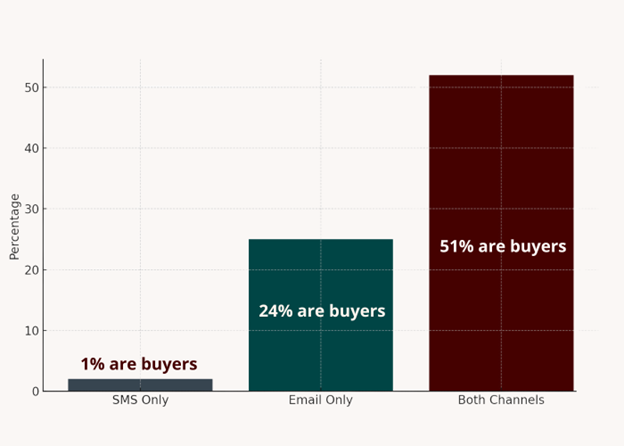Beyond the Inbox – Creating synergy with Email and SMS
Why adding SMS to your Email Marketing Journey is a good thing
I would have rolled my eyes a year ago if you had told me I would write a blog about adding SMS to the mix. But today, my view has shifted. SMS, like email, is a great retention channel. Sure, it can be annoying—just like daily emails can be—but when used strategically, it has a valuable place in the customer journey alongside email. The key is knowing how and when to use SMS and email to increase brand engagement.
Let’s start with why I changed my view.
Right before the holiday season of 2023, I met with a client. We were brainstorming ideas, and SMS was brought up. Both of us were hesitant to launch it, but with my email marketing hat on, I said, “Well, we should test it.”
The program started VERY small. We only used it to mention BFCM deals, and even that was limited. We also only used the email channel for SMS acquisition because SMS costs are high, and we had yet to determine if this program would be successful. We also understood the email audience, and their engagement was strong.
As I was recently prepping to speak at two different conferences, I started to research and analyze how things were looking for this client on their SMS strategy, especially since it still closely aligns with the email program.
51% of those who opt-in for both channels are buyers. By using SMS to complement the already successful email program, we can quickly send last-minute messages, which results in additional revenue for the brand. We still see more revenue from the email channel, but that channel has been around for much longer. However, those who are on both channels are truly the highest-value customers.

According to Attentive, 85% of consumers who opt for SMS also opt-in for email, and those who opted into both channels are 2.4 more likely to purchase.
So, how can we, as email marketers, add SMS to the mix and avoid the batch and blast we avoid for email?
As with any new channel, developing a plan to add this to the retention flow is essential. Here are five recommendations I have when considering adding SMS to the mix.
1) Be strategic about using both channels
One of the things I love about retention marketing is that it is all about the right channel and message. This means that when you add SMS, you need to tailor your messages and timing to ensure that email and SMS complement each other and that you aren’t sending the same message to both who are on both channels.
2) Audience Segmentation
Similar to email, SMS should be segmented. As you can see above, we know precisely who purchases based on the channel, but beyond that, we also know what people clicked on in the email, so consider using SMS to supplement. For example, if they open but don’t click, maybe send an SMS follow-up with one of the products in the email. One of the things I have seen that works among my clients for SMS are messages such as “one left in stock” or early access. Something to remember about SMS is that it is short and to the point.
3) Leverage Automation
The one that comes to mind first is an abandoned cart. Consider the following: Send the abandoned cart email 12 hours after the cart abandonment. If the purchase still doesn’t happen, try following up with an SMS. As with anything TEST, don’t just apply this path and run with it.
Another great way to use SMS is for customers who have stopped engaging with the email channel. SMS might be the perfect way to win them back as customers.
4) Focus on Cross-Channel Journey Mapping
Each channel plays a unique role in the customer journey, and the importance of email versus SMS changes depending on where someone is in the buying process. Email is ideal for delivering longer, more detailed messages, while SMS is suitable for short, quick information. As you map out how SMS fits into your email marketing strategy, consider how to handle subscribers who opt into both channels at once. Is it necessary to send a welcome message via both SMS and email? You may want to stagger those and send slightly different messages. What about those who have been on your email list for a while and then opt into SMS? Speaking to them based on their existing journey with your brand is essential. They are the same subscriber but now tell you they want to hear from you on another channel.
Designing a seamless cross-channel experience means strategically using email and SMS at different stages to ensure each message serves a clear purpose.
5) Frequency Control & Message Timing
When I think about the frequency and timing of SMS, I first think that SMS is like a phone call. It can play a sound on someone’s phone the minute it arrives (yes, the same can be said for email, but I don’t find email intrusive). SMS arrives at the same place my husband, parents, and friends text me about dinner plans. The last thing you want is for your messages to arrive at an annoying time. Thankfully, most SMS tools provide for quiet hours. SMS, similar to email, should not be batch and blast. If someone is also on your email list, do you need to send them a daily email and SMS? Just as you are with your email list, your strategy should control both the frequency and timing you are sending.
So, back to why adding SMS to your Email Marketing Journey is a good thing…
Incorporating SMS into your email marketing strategy is another way to connect with your audience. By leveraging the strengths of each channel, you can build a stronger connection, leading to increased value for the subscriber and increased revenue for your brand.
 Photo by Joanna Kosinska on Unsplash
Photo by Joanna Kosinska on Unsplash

 How to resolve AdBlock issue?
How to resolve AdBlock issue? 
